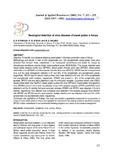| dc.contributor.author | Nyaboga, E. N | |
| dc.contributor.author | Ateka, E. M | |
| dc.contributor.author | Bulimo, W. D | |
| dc.date.accessioned | 2013-05-29T14:52:44Z | |
| dc.date.available | 2013-05-29T14:52:44Z | |
| dc.date.issued | 2008 | |
| dc.identifier.citation | Serological detection of virus diseases of sweet potato in Kenya, Nyaboga, E. N., Ateka E. M., and Bulimo W. D. , Journal of Applied Biosciences, Volume 7, p.222 – 229, (2008) | en |
| dc.identifier.uri | http://profiles.uonbi.ac.ke/wallacebulimo/publications/serological-detection-virus-diseases-sweet-potato-kenya | |
| dc.identifier.uri | http://erepository.uonbi.ac.ke:8080/xmlui/handle/123456789/27162 | |
| dc.description.abstract | Objective: To identify virus diseases attacking sweet potato in the major production areas in Kenya.Methodology and results: A total of 220 symptomatic and 108 asymptomatic sweet potato vines were collected from farmers’ fields, established in an insect-proof screenhouse and tested for viruses by nitrocellulose membrane enzyme-linked immunosorbent assay (NCM-ELISA). The viruses detected were Sweet potato feathery mottle virus (SPFMV), Sweet potato chlorotic stunt virus (SPCSV), Sweet potato mild mottle virus (SPMMV) and Sweet potato chlorotic fleck virus (SPCFV). SPFMV was the most prevalent virus and the most widespread, detected in 67 and 20% of the symptomatic and asymptomatic plants, respectively. SPCSV was the second most common and it was detected in 64 and 13% of the symptomatic and asymptomatic plant samples, respectively. SPMMV was present in 12% of the symptomatic plant samples. SPCFV was rare, being detected in only 4% of the plant samples. Cucumber mosaic virus (CMV), Sweet potato latent virus (SwPLV), Sweet potato caulimo-like virus (SPCaLV), Sweet potato mild speckling virus (SPMSV) and C-6 virus were not detected in any of the samples assayed. SPFMV and SPCSV were detected in all the 15 districts that were surveyed, whereas SPMMV and SPCFV were detected in 9 and 4 districts, respectively. Five different virus complexes were detected in the samples assayed. Dual infection with SPFMV and SPCSV was the most common multiple infection and was detected in 52 and 12% of the symptomatic and asymptomatic plants, respectively.Conclusion and application of findings: This study has provided a quantitative assessment of co-occurrence of viruses in sweet potato plants in Kenya, and highlights the importance of developing resistance specifically targeting SPCSV in either conventional or non-conventional breeding programs as a means of virus disease management | en |
| dc.language.iso | en | en |
| dc.publisher | University of Nairobi. | en |
| dc.title | Serological detection of virus diseases of sweet potato in Kenya | en |
| dc.type | Article | en |
| local.publisher | College of Health Sciences, University of Nairobi, Kenya | en |


